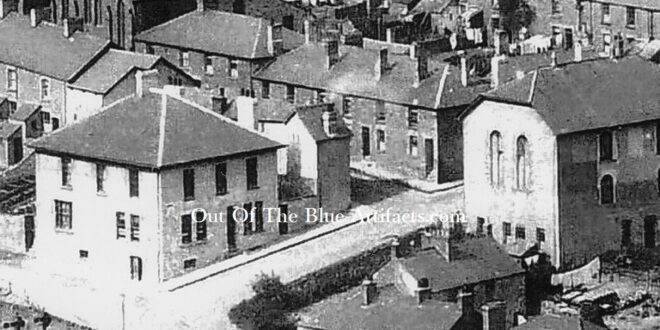Abertillery Fire Brigade.
On Tuesday 1st of July 1890, a meeting of the Abertillery Chamber of Trade held at the National Schoolroom with the following members – Mr L. R. Rogers (Chairman); Mr D. Gulliford; Mr George Gregory; Mr J. Wright; Mr H. Cole; Mr Joseph Price; Mr J. Thomas; Mr D. Harris; Mr Jesse Carter; Mr J. E. Phillips; Mr A. H. Thomas; Mr W. B. Harrison; Mr W. T. Michael; Mr J. Thomas; Mr J. Wallace; Mr Thomas Robins; Mr Arthur Tilney; Mr J. W. Williams; Mr F. J. Lane; Mr Williams (Ironmonger); Mr J. Phillips; Mr C. Carpenter and Mr J. T. Baker (Secretary): Mr W. B. Harrison gave notice that at the next meeting he would call the attention of the chamber to the advisability of forming a volunteer fire brigade for the town and district.
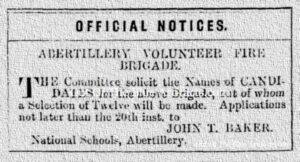 On Monday 9th of February 1891, a meeting of the Abertillery Chamber of Trade held at the National Schoolroom confirmed the set-up of the Abertillery Voluntary Fire Brigade and to form a committee. Tenders were put out for the services of twelve men to form the brigade and that for the supply of uniforms.
On Monday 9th of February 1891, a meeting of the Abertillery Chamber of Trade held at the National Schoolroom confirmed the set-up of the Abertillery Voluntary Fire Brigade and to form a committee. Tenders were put out for the services of twelve men to form the brigade and that for the supply of uniforms.
The Selection of the Applicants.
On Friday 20th of February 1891, the Chamber of Trade set up a committee to deal with the voluntary fire brigade and met at the National Schoolroom, Abertillery. Those present were as follows – Mr L. R. Rogers (Chairman); Mr A. Tilney; Mr J. Wallace; Mr M. Emmanuel; Mr J. Burgess and Mr J. T. Baker: The following twelve candidates were elected members of the Brigade – Mr J. Burgess; Mr G. Scudamore; Mr M. Emmanuel; Mr R. Ayers; Mr William Jordan; Mr A. Everson; Mr J. Saxon; Mr J. Rex; Mr William Smith; Mr James White; Mr John Davies and Mr James Mundy: The tender of Mr John Owen of Pontlottyn Store, Abertillery for the uniforms was accepted. The committee stated they were to hold two concerts at Abertillery and Cwmtillery at an early date to form a fund to defray the expenses.
On Tuesday 17th of March 1891, at a meeting of the volunteer fire brigade committee held at the Abertillery National School, Mr L. R. Rogers (Chairman) and Mr Edgar Webb (Solicitor) Aberbeeg, stated that Mr Webb had promised to give the movement his support. Mr Wallace stated that the Abertillery Local Board had gave £25 towards equipment. Mr Wallace was elected treasurer and Mr Webb was invited to take the captaincy.
The Fire Engine Debate.
On Thursday 7th of May 1891, at an annual meeting of the Abertillery Local Board a report on the finance of equipment was read from the meeting between a deputation from the chamber of trade and the local board. It stated the full equipment including a 15 per cent discount would cost £150. One hundred feet of hose was also asked for and the chamber thought a new engine should be purchased instead of a second hand article. The concern of the inability to protect the area from fire would be compromised in the lack of funding and said that they should look at hiring an engine and appliances for a few months as an experiment. A list of manufacturers were read out and the firm of Messrs Shand, Mason & Co offered a second hand engine for £75 whereas a new engine was to cost £135 which in total the equipment would cost £150. The scarcity of the availability of water was noted and the meeting was adjourned until the opinion of an expert was sought.
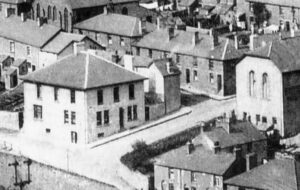 The First Fire Station.
The First Fire Station.
Soon after the formation of the brigade, the small building on the lower end of Chapel Street at the rear of the council offices (as seen in the center of the image with smoke coming out of its chimney) was used as a fire station. I’m not sure if this building was purposely built as a station or if it was purchased by the brigade?
Captain F. Fielding.
In January 1898 Mr F. Fielding was made Honorary Captain of the Abertillery Fire Brigade and was supplied with an officer’s outfit.
Messrs England Bros.
In February 1898 Messrs England Bros, general hauliers of Abertillery were asked to quote terms for providing a brake and two horses to take the firemen to the scene of any fire and the conveyance was to be at the command of the council whenever required.
The Electrical Call System.
In April 1898 an electrical call system was installed at the station Abertillery for the cost of £100.
On Monday 9th of May 1898, at a meeting of the Abertillery District Council the Fire Brigade Committee decided to issue the captain of the fire brigade a journal for him to write monthly reports on the brigade. Also a fire-escape was to be ordered. It was also stated that they are to rent the house next door to the fire station belonging to Mr Titus Phillips as a central fire-call station and a depot for the fire escape. It was stated that Fireman Rogers was to have the house rent free in consideration of his undertaking to test all the hydrants north of Aberbeeg at least once a month with a wage of 18s. per week.
Captain Burgess.
In January 1899 Mr Burgess was Captain.
Firemen’s Insurance Payments.
In July 1899 it was proposed by Mr Carpenter that the Abertillery Firemen should be insured. It was later reported in March 1901 that the firemen would be insured for 5s. per year per man.
The Telephonic Communication System.
In November 1899 it was proposed to install a Telephonic Communication System at the station at a possible cost of £286, equivalent to £35,464,00 in today’s money.
On Monday 12th of March 1900, an Abertillery District Council meeting heard that the captain had resigned and that Mr Pittaway the lieutenant was the new captain and that Mr Britton (Mechanical Engineer at the Tillery Collieries) should be the new lieutenant.
The Firemen’s Wages.
In 1900 the firemen’s wages were as follows – The captain – £15 per annum, lieutenant – £10 per annum. All members of the brigade would receive – 2s. 6d. per drill 13 times per year. In case of a call to a fire 5s. paid to each man with an additional allowance of 2s. per hour after the first hour. The captain’s salary at £15 per annum is equivalent to £1,895.35p in today’s money.
In July 1901 the tender of Messrs Liscombe of Newport was accepted for the supply of new hoses and couplings for £31. It was also recommended to the council to purchase 100-foot ropes and a jump-sheet.
In November 1905 the council stated that Fireman Rancombe’s wages were £1. 10s. 0d. per month and that his duties were the cleaning of the station and appliances, attending to the ordinary repairs of the appliances and attending to the alarm bells.
Chapel Street Cottages.
On Monday 14th of January 1907, at an Abertillery District Council meeting held at the Council Offices, Hill Street, Abertillery the Fire Brigade Committee reported that in consideration of the frequent changes of address of the firemen in Abertillery and for the expenditure of re-fixing the fire alarms, the question of making arrangements with a view of obtaining six cottages in Chapel Street should be approached for the use of firemen’s housing and brigade purposes alone.
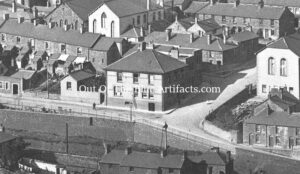 The image (left) shows the Abertillery Fire Station on Chapel Street after the renovations, it then had a flat roof. To the left of the council offices is the area where the new fire station would later be built.
The image (left) shows the Abertillery Fire Station on Chapel Street after the renovations, it then had a flat roof. To the left of the council offices is the area where the new fire station would later be built.
The New Fire Station on Castle Street.
In 1911 the fire station on Chapel Street was becoming too small for purpose and the council began planning the new fire station, sometime between 1912 and 1913 the new station had been erected and was constructed on land next door to the Abertillery Council Offices on Castle Street, Abertillery.
On Monday 22nd of January 1912, at a meeting of the Allotments, Pleasure Grounds and Fire Brigade Committee the surveyor submitted plans of the new Abertillery Fire Station which was proposed to be built adjoining the Abertillery Council Offices in Castle Street. The cost was estimated at £400.
The New Fire Engine.
In April 1913 Abertillery had a motor fire engine, the engine which cost £1,060 was supplied by Messrs Henry Simonis and Co of the Pretoria Works, Walthamstow, London. The motor engine was between sixty and seventy horsepower with two entirely different systems of ignition. The principal pump was on a turbine high lift pump principle on the Mather and Pratt design and was capable of delivering 400 gallons of water per-minute against a total pressure of 140 pounds per square inch. The pump was primed by means of a separate positive acting rotary pump and was supplied with suction and twin delivery outlets. The first aid engine which was of the London design was adapted for putting out cottage fires and could be brought into action immediately on reaching the scene of a fire.
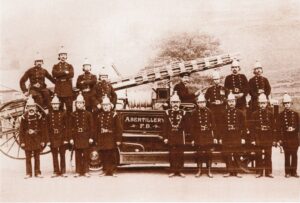 The engine was made of copper and tested to 250 pounds, fitted with a safety valve and pressure gauge with a Simonis three-way connection allowing also the use of the hydrant pressure if the gas was exhausted. The water was ejected by means of a gas system under pressure up to 125 pounds. The cylinders were in permanent connection with an automatic hose reel on which 150 feet of hose was fitted with a stop cock, nozzle and all connections. The fire-escape was of a Simonis double wood trussed “Pretoria” construction, fitted with automatic safety stops with plumbing gear, automatic locking lever and is on a special sliding table carriage. The escape was in three sections and could reach a height of 50′ feet. There was 1,200′ feet of hose fitted with extension couplings. The whole engine was painted red vermilion outlined in gold, with brass edging and rails. “Abertillery FB” was painted along the side of the fire engine.
The engine was made of copper and tested to 250 pounds, fitted with a safety valve and pressure gauge with a Simonis three-way connection allowing also the use of the hydrant pressure if the gas was exhausted. The water was ejected by means of a gas system under pressure up to 125 pounds. The cylinders were in permanent connection with an automatic hose reel on which 150 feet of hose was fitted with a stop cock, nozzle and all connections. The fire-escape was of a Simonis double wood trussed “Pretoria” construction, fitted with automatic safety stops with plumbing gear, automatic locking lever and is on a special sliding table carriage. The escape was in three sections and could reach a height of 50′ feet. There was 1,200′ feet of hose fitted with extension couplings. The whole engine was painted red vermilion outlined in gold, with brass edging and rails. “Abertillery FB” was painted along the side of the fire engine.
The engine arrived at Newport on the Wednesday when it was inspected by members of the Abertillery District Council while attending a meeting of the Joint Water Board, they returned up the valley on the engine driven by Mr Thurling of the Abertillery Fire Brigade. A halt was made at Llanhilleth where a demonstration was made of the powers of the engine. On the Thursday afternoon an opening demonstration took place on the square near the tin works attended by the council members, fire brigade and general public. Four jets of water were played on the Railway Inn and the tin works offices etc, the fire escape was demonstrated, also proving that Abertillery possessed the means of dealing with the most serious conflagration. The council also stated that the remodelling of the fire station is to get underway and the surveyor was to proceed with the plans.
In the early 1930s the Abertillery Fire Brigade consisted of the following members – Mr Rancombe (Captain); Mr S. Jenkins; Mr E. Childs; Mr V. Sugg; Mr G. Langley; Mr J. Hill; Mr F. Watkins; Mr T. Booker. Mr W. Williams; Mr W. Williams and Mr F. Childs.
The Fire at Cwm, Ebbw Vale.
In July 1937 the was a blaze in Cwm, Ebbw Vale which resulted in one death and four houses in Canning Street being destroyed, the Ebbw Vale Fire Brigade were overwhelmed and had to call on Abertillery for assistance, the Abertillery Fire Brigade turned up in their new 45 h.p. fire engine named the “Tyleri” and their state of the art engine (a much smaller engine capacity but faster and more efficient) pumped water from the nearby river at 250 gallons of water per minute to help extinguish the inferno.
New Fire Station Proposal.
In the early 1950’s it was seen that a new modern fire station was needed to serve Abertillery and in 1952 the County Fire Officer and the County Planning Officer were looking for new places at Abertillery as a new fire station for the town. In October 1952 a site at Rose Heyworth Road was proposed and in November 1952 they visited the old wheelbarrow factory at Richmond Road to house a three-bay fire station. The need for a new fire station was put on hold until the early 1960’s.
On Tuesday 2nd of April 1963, the Monmouthshire County Council issued a statement stating that they purchased the Tillery Sidings at Abertillery and that they would be used for a new fire station and possibly for other social services. The council had been approached by Messrs D. Rees & Sons of the Golden Crust Bakery for the use of the site, they were to build a new bakery upon the old sidings ground and employ many people to work there, Messrs Rees told the council if they could not have the ground they were going to move from the area. They were considering the bakery proposal though the council had plans for a scheme to construct a group of civic buildings which would include a public library, a registrar’s office, youth centre and a health clinic, the location was ideal for the long-term planning, so the bakery proposal was refused. The council went ahead with the construction of the new fire station, the overall scheme involved an expenditure of £150,000.
The New Fire Station.
In January 1966 the new Abertillery Fire Station had been completed and was opened for active service. The new station cost £52,000 and was the first building constructed within the scheme built on the site of the old Tillery Sidings, Abertillery.
The Official Opening of the New Fire Station.
On Saturday 19th of March 1966, the new Abertillery Fire Station was officially opened. County Councillor Mr Pardoe James, chairman of the county fire brigade committee presided and Alderman Sir Thomas Mytton performed the opening ceremony.
A Description of the Building.
The new fire station was said to have been a model of its kind with the latest types of firefighting equipment. It had its own emergency power unit which supplied electricity to the station in the event of a power cut, had a telephone switchboard with room for twelve extensions and a private emergency line to Blaina. The new station was responsible for turning out the appropriate brigades throughout the district as all calls from Llanhilleth to Brynmawr including Trinant was sent to Abertillery.
The Abertillery Fire Station had two fire engines with one having a 50′ foot fire escape and the other having a 35′ foot expanding ladder. They also had a land rover with a 350 gallon-per-minute pump and was the latest model of its kind in the county. There were fifteen full-time firemen and fifteen part-time firemen employed at the station.
The Later Years.
On the 18th of February 2017 the police and ambulance services at Abertillery moved in to the Abertillery Fire Station so that the three services were all under one roof.
Points of Interest –
Messrs H. Lotery & Co.
In March 1965 the premises of the old Abertillery Fire Station on Castle Street was taken by Messrs H. Lotery & Co. The managing director Mr W. M. Saunders stated the company would be making uniforms for various services and initially they would be employing 30 to 40 girls. Messrs Lotery & Co Ltd were based at Herbert Road, Newport.
In August 1966 it was announced an extension had been built at the clothing factory which enabled Messrs H. Lotery & Co to employ 150 women at the factory.
The Old Council Offices.
Messrs H. Lotery & Co were not the only clothing business in that area as in 1962 Messrs J. Harvey Ltd a clothing firm based at Tredegar opened a clothing factory at the vacant council offices on the junction of Castle Street and King Street, Abertillery. The old council offices were converted into three large rooms with 25 machines in each room. The company were making duffel coats. Messrs Harvey Ltd initially employed 50 women and intended to employ up to 100 women. Mr A. White was works manager. The factory closed in 1965.
(More information to come).
 Out Of The Blue Artifacts A Library of a lifetime of collecting
Out Of The Blue Artifacts A Library of a lifetime of collecting
